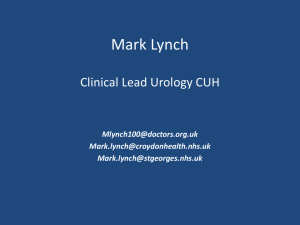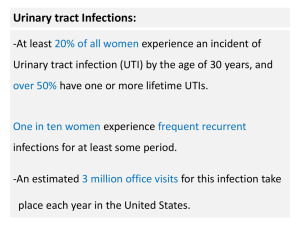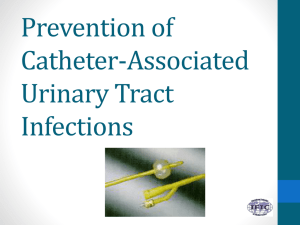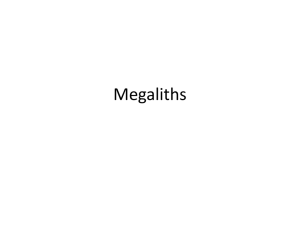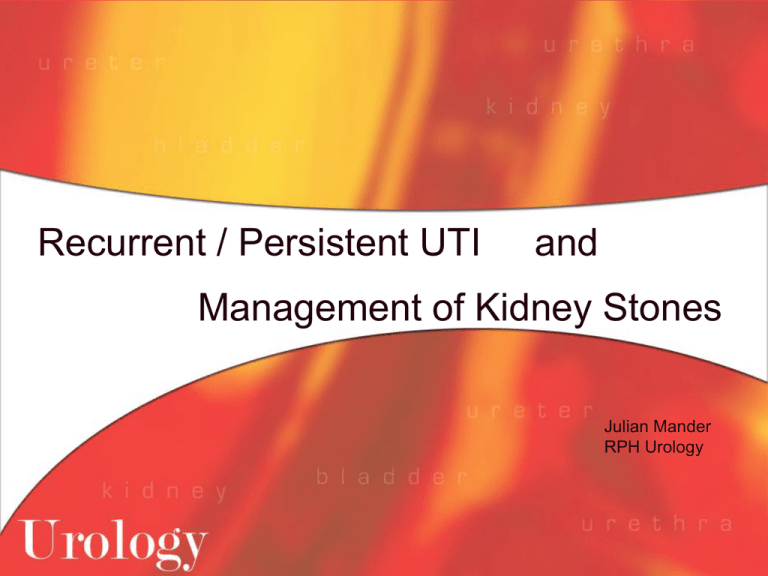
Recurrent / Persistent UTI
and
Management of Kidney Stones
Julian Mander
RPH Urology
Persistent UTI
Persistent UTI implicates an underlying infective focus, not
cleared until the underlying problem is dealt with.
Always the same organism on MSU. MSUs remain positive
after treatment and between clinical episodes.
Classically Proteus and infection staghorn stones, classically
older females. Infection not cleared unless stone cleared.
In males, commonly persisting prostatic infection, typically
not cleared with cephalexin or amoxycillin – use
trimethoprim or norfloxacin (or ciprofloxacin) in men.
Recurrent UTI
Recurrent UTI means reinfection, typically with varying or different
organisms.
Definition:
Three or more MSU documented UTIs within 12 months.
3% of women, uncommon in men.
Urine cleared of bacteria in between clinical episodes c/f persistent UTI
not cleared.
Recurrent UTI
1/3 of women with recurrent UTI in adult life had their initial UTI during
childhood.
UTIs tend to occur in clusters in those with recurrent UTI.
Predisposing factors are unclear –
sexual intercourse in women
estrogen deficiency in post menopausal women altering vaginal flora
Role of residual urine poorly studied, assumed that PVR > 100 ml
associated with recurrent UTI (?180 ml), but PVR proportional to
starting volume and bladders always overfilled for U/S.
Pathophysiology Recurrent UTI
Bacteriuria is common in women, but established UTI/cystitis relatively
uncommon – why do some women get recurrent UTI whilst most don’t ?
All bacteria invading the urinary tract activate an inflammatory response in terms
of neutrophil infiltration, important to clear the bacteria.
Extent to which different organisms activate the inflammatory response varies
markedly, and the relationship of this activation to different disease states is
complex.
Deficiency in activation of inflammatory response in some people predisposes
them to infection.
Bacterial attachment to mucosa is important, bacteria – host interaction here is
important and poorly understood.
Secretor Status
Mendelian dominant inherited characteristic of secretion of
water soluble form of antigen immunodominant sugars
- Blood group A: N acetyl-D-galactosamine
B: D-galactosamine
Non secretors linked with relative deficiency of certain
immunoglobulin classes.
Non secretors have more infections, including UTI’s.
Suggestion that non-secretors have less efficient immune
systems
ABO Blood Group Status
Blood group B have 50% greater chance of UTI than non-B group.
Blood group AB also have a higher incidence of UTI.
Absence of anti-B isohaemaglutinin renders individual more
susceptible to UTI.
Large number of bacteria cross react with anti ABO blood group
isohaemaglutinins.
These cross reacting antigens vary in their immunogenicity.
“B-like” immunogen is particularly antigenic and may increase
the naturally occurring isohaemaglutinins, inhibiting bacterial
attachment and colonization and increasing susceptibility to
compliment.
Humoral Response
Superficial infection results in the formation and release of secretory IgA.
UTI causes a selective and up to four fold increase in IgA secretion.
Some adults with UTI appear to have a defect in the maturation of sIgA.
Superficial vs Intracellular infection – recent work on intracellular infection
and the detection of IBCs – intracellular bacterial communities –
relevant to clearance of infection and persistent UTIs.
Moving from superficial to intracellular infection is poorly understood, but
humoral and subsequent inflammatory response and neutrophil
recruitment is thought to be important.
Investigation
MSUs critical for correct management
Ultrasound kidneys and bladder residual
(n.b. without bladder overdistension, which will give
artificially elevated PVR – good U.K. study showing PVR
proportional to pre void volume)
Cystoscopy usually unnecessary if PVR is OK and patient
not had frank haematuria.
MSU tests
Critical in the management of recurrent / persistent UTIs.
Irritative LUTS not always UTI! - Interstistial cystitis, lower
ureteric stone, bladder cancer esp CIS.
Urinalysis dipstick tests – OK for screening / diagnosis in non
complicated UTI 90% specificity 90% sensitivity.
►Females - if more than one presentation with cystitis within
12 month time frame – DO
MSUs.◄
►Males – any presentation with cystitis symptoms – DO
MSUs◄
Treatment Persistent UTIs
Remove the source of persisting infection:
Staghorn stones – require complete clearance and follow up.
Clear prostatic infection in men.
Remove foreign bodies – JJ stents, catheters
Treatment Recurrent UTIs
Behavioural modification
Cranberry juice
Probiotics – “Good bacteria”
Antibiotic treatment
Antibiotic prophylaxis
Bacterial vaccines
Behavioural Modification
Avoiding sex works for some women, but strains
relationships.
Anal sex probably predisposes men to UTI, but is generally
not discussed, and there are no scientific papers
discussing this.
General hygiene advice is a waste of time, and makes
women feel they have poor hygiene.
Cranberry Juice
Antibacterial action due to aromatization of quinic to benzoic acid in the
gut.
Benzoic acid converted to hippuric acid in the liver, excreted in urine.
Hippuric acid (Hiprex!) converted to formalin in the bladder in the
presence of acidic urine (Hence Hiprex + NH4Cl or ascorbic acid).
Requires high residual volumes. (Kass 1959)
Also said to release organic molecules into urine which block bacterial
adherence (pro-anthocyanidins which prevent docking of bacteria on
A-type linkage of flavanols). (Analogous to secretion blood gp Antigns)
Some evidence for effectiveness in simple recurrent UTI in women
(300ml/day)
Probiotics “Good Bacteria”
(By definition, a probiotic is any substance containing live organisms that,
when ingested, have a beneficial effect on the host by altering the
body's intestinal microflora)
No evidence that they reduce incidence of UTIs
Lactobacillus preparation and antibiotic associated diarrhea with Rx UTI
17% absolute risk reduction in diarrhea associated with antibiotic
administration, and significant reduction in risk of Clostridium difficile
infection, in patients given lactobacillus drink – suggested as routine
admin to hospital patients > 50 that are receiving antibiotics
Use of probiotic Lactobacillus preparation
Hickson et al
BMJ 2007; 335 (7610): 80
Antibiotic Resistance
Most commonly associated with multiple courses of full dose antibiotics
for recurrent UTIs.
Do not use antibiotics in patient with an indwelling catheter unless they
are septicaemic.
Do not use antibiotics in patients with infection stones, unless
septicaemic.
Do not use antibiotics in pateints with JJ stent unless MSU positive.
In patient with recurrent UTIs, MSU documentation is vital for assessment
of antibiotic sensitivities and resistance.
Antibiotic Treatment
Amoxycillin simply doesn’t work – always recurs (Kincaid Smith) – seems OK with
clavulinic acid though.
Urosepsis T > 38 = hospital and I/V antibiotics + renal U/S exclude infected
obstructed.
Gentamicin + Amoxycillin (Enterococcus) monitor levels
or Timentin
Males – all males with UTI have prostatitis (just (don’t) do PSA!!) – prostatic
persistence allegedly due to inactivity Abs in acidic pH prostatic fluid.
Trimethoprim or fluoroquinolones (Norfloxacin) best – requires 2 weeks Rx, 4
weeks if recurs. Most commonly older men with Rx Cephalexin failure seen.
Pyelonephritis best at least 2 weeks antibiotics.
Antibiotic Treatment
New work on intracellular infection as cause of complicated UTI.
Diagnosis of IBCs on urine cytology or biopsy with EM.
Most effective intracellular Abs are fluoroquinolones. May explain
observed increased efficacy for these drugs – but should be reserved
for complicated UTI.
Antibiotic Prophylaxis
Treatment for recurrent UTIs 95% success Use after clearance of UTI with full dose Ab,
U/S clear. Prescribe antibiotic pending sensitivities.
Not for catheter (IDC) related infection, or persisting UTI.
Nitrofurantoin most commonly 50 mg before bed (no alteration gut/vaginal flora)
Cephalexin 250 mg
Augmentin Duo
Trimethoprim (150 mg) linked to early multi resistance
Authority prescription for “complicated UTI” on 1800 888333
6 months generally ? 12 months for elderly. Permanent on 6 month rotation for early
recurrence or repeated problems. Post intercourse tablet can work.
Bacterial Vaccines
Phase II trial published April 07 in a group of women with 3 or more UTIs in 12 months
Vaginal pessaries containing “Urovac” vaccine contains heat killed bacteria from 10 human
uropathogenic bacteria:
6 strains E coli
1 strain each of Proteus, Morganella, Klebsiella, Enterococcus
Vaccine with or without boosters. 3 pessaries at weekly intervals with boosters 1 pessary
monthly for 3 months.
72% infection free over 6months in treatment group with boosters vs 30% infection free in
placebo group, but placebo group only 3 subjects.
Vaginal Mucosal Vaccine for Recurrent UTI in Women
Hopkins et al
J Urol 2007; 177:1349
Management of Kidney
Stones
Julian Mander
Spontaneous Stone Passage
Most stones will pass spontaneously and don’t require surgical intervention.
80% of 5 mm stones will pass spontaneously.
50% of 8 mm stones will pass spontaneously.
Stones in the lower ureter at presentation more likely to pass than stones in
the upper ureter.
Typically episodic pain will be experienced while stone is passing.
Adequate pain relief is important for expectant management – NSAIDs.
Irritative LUTS with stone in lower 1/3 ureter ≠ UTI.
Dissolution of Uric Acid Stones
pKa Uric acid = 5.75
Urine pH 7 80% urate ionized
Urine pH > 7.5, increase Ca deposition on stone -> insoluble
Rx Sodibic 840 mg qid or Ural sachets one qid
Repeat imaging 6 +/- 12 weeks
Not dissolved -> surgery
Prevention increase urine output > 2 li / 24 hours
allopurinol 300 mg or 100 mg daily
? decrease protein intake 90 gm / 24 hours
? Run urine pH 7
Indications for Surgical Intervention
1. Infected obstructed kidney = surgical emergency
2. Pain uncontrolled despite PR NSAIDS
3. Stone clearly too large to pass > 8mm
4. Significant CRF creatinine >200
5. Solitary kidney – risk obstructive uropathy
Surgical Intervention – JJ Stents
GA + Cystoscopy – low morbidity
Initially described late 1970’s, not in common usage until 1980’s
Initially no longer than 6 or 12 weeks because of encrustation
Now new polymers 6 months, silastic stents 12 months
Risks -
septicaemia following insertion infected obstructed
ureteric perforation
misplacement if not done with contrast and II
stent pain 15% unable to tolerate Rx as renal colic NSAIDs
loin pain with voiding
cystitis symptoms - do MSU not dipstick which is always +ve
delays stone passage, but enables future instrumentation
JJ Stents
Surgical Intervention – Rigid Ureteroscopy
Scopes
Perez – Castro early 1980’s 12 F
Uromat water pressure devices mid 1980’s
7.5 – 8.5 scopes 1990s
Fragmentation
EHL probes and U/S probes 1980’s
Pneumatic lithoclast probes 1990’s
Risks: - ureteric perforation
- ureteric stricture
Use: still best option for lower 1/3 ureteric stones
Rigid Ureteroscope
Surgical Intervention – Flexible Ureteroscopy and Laser
Flexible ureteroscopes 1990’s 7.5 F late ’90s
poor durability – 6 week lifespan @ $15,000
Holmium YAG laser 1990’s, prostates initially
$120,000 machine
200 micron fibers $800 - $2000
Risks - ureteric strictures
- urosepsis and death still with infection staghorns
Failures – narrow UOs - dilators
- narrow ureters – pre stent
- lower pole access
Flexible Ureteroscopy
Flexible Ureteroscopy Views
Surgical Intervention - ESWL
First treatment Stuttgart 1980
Dornier HM3 1983
RPH Seimens Lithostar 1991
RPH Dornier 2001
GA or LA
Opaque stones only (U/S guidance available)
3000 shocks – treatment about one hour
Pre stenting – stones > 2 cm
- infection stones
Risks – pain passing stone fragments
?late hypertension
- obstruction (steinstrasse) +/- infection
- renal haemorrhage and kidney loss (beware coagulopathies)
Success rates – pelvicalyceal 80% stone free rates
Surgical Intervention – Percutaneous Nephrolithotomy
1970’s Whickham, London – Seldinger technique for renal puncture
1982 – 83 Pat Bary RPH pioneered in WA
Upper vs Lower pole punctures – upper pole later + supra 11th rib
Access failures
Anatomical failures – parallel punctures, coagulum extraction
Single stage 30F Amplatz dilatation eventually
Fragmentation development – EHL, U/S, pneumatic Lithoclast
Risks – bleeding 7% transfusion rate RPH (Kaye tamponade balloon)
- 1/200 kidney lost with each puncture & dilatation
- nephrectomy for bleeding occasionally
- deaths from urosepsis with infection staghorns
- bowel, sleen and liver injuries
PCN
Open Surgery Uretero/Pyelo/Nephrolithotomy
Occasionally pyeloplasty for PUJ obstruction, with pyelolithotomy
Pyelonephrolithotomy for staghorn stones – lost art
- splitting kidney on Brodel’s line
- Renacidin irrigation
- Coagulum pyelolithotomy
- renal Xray plate
- Gil – Vernet’s plane in pyelolithotomy
- clamp and cool kidney
Risks – loss renal function
- sepsis
- loss kidney
Staghorn Stones
Generally elderly, unfit and infected
Mortality from urosepis
High recurrence rate 15 – 30%
Sepsis not cleared unless stone cleared
Commonest cause of persisting Proteus infection
Surgery - now the most common indication for PCN
- “sandwich” with ESWL
- ? role of flexi ureteroscopy and laser
- ? ESWL de novo – some reports
Staghorn Stones
Pregnancy – Special Case
Concern is preterm labour – with or without intervention
Greater concern the earlier the pregnancy
Xray exposure concerns at all stages, greater in first trimester
NSAIDs unable to use because of ductus closure risks
Traditional management:
U/S diagnosis hydronephrosis +/- stone
manage with U/S alone if small and pain manageable – rare
intervention required – do V. Limited IVP - control +5min + 30min
ureteroscopic vs open - issues with stents AVOID
Latest: U/S diagnosis followed by immediate flexi ureteroscopy + laser
No Xray usage at all
Waterson et al Urology 60:383-7 2002
“Metabolic Workup”
Recurent stone former = 2 or more stones
Biochemical stone analysis important
IVP for medullary sponge kidney in Ca Ox stones
Serum calcium, albumin, uric acid repeated
MSU ?UTI ?pH (Type 1 distal RTA fasting urine always pH > 5.3)
24 hour urine Calcium
Oxalate
Uric acid
+/- Cystine
PTH assay in Calcium stone patients
Renal Acid load test for RTA “persisting fasting alkaline urine in
presence of hypercalciuria and CaPO4 stones
Medical Management – Cystine Stones
Inherited defect renal tubular reabsorption 4 amino acids COLA
Autosomal recessive, but some heterozygous have problem
pKa cystine higher than uric acid - increase solubility only at pH > 7.2
- double solubility at pH 7.8
Dissolution - > 2 li urine / 24 hours – best 3 – 4 li !!
- pH > 7.8 Kcitrate thought best, but can use NaHCO3
- often not successful
Thiol group donors – D Penicillamine 1.5 gm / day
- form cystine-S-penicillamine soluble molecule
? ACE inhibitor - captopril
Medical Management – Infection Stones
MgNH4PO4 = struvite with proteinaceous matrix
Urea splitting bacteria, produce urease enzymes, splitting urea to
ammonium, increase urine pH and may provide initial glycocalyx
proteinaceous compound.
Urine pH > 7.2 required
Proteus commonly, also some Pseudomonas, Klebsiella, E coli
Persisting Proteus UTI is hallmark (esp diabetic Aboriginals – E coli)
Surgery to clear stone, followed by one month full dose bacteriocidal
antibiotic, followed by 12 month surveillance with monthly MSUs
? Hemiacidrin irrigation following surgery
? Oral urease inhibitors
Medical Management – Calcium Stones
47gm calcium filtered daily, UOP 200 mg Ca/day = > 99% reabsorbed
Tubular transport max exceeded -> hypercalciuria
Ksp need only exceed 15 – 30 minutes to nucleate stone
Concept of heterogenous nucleation
Hypercalciuria Vs Hyperoxaluria - Ionic activity
? Oxalate 10 x more important in CaOx stone formation
Medical Management - Hypercalciuria
Hypercalciuria
Absorptive 1. Type 1 hypercalciuric on low Ca diet
2. Type 2 hypercalciuric on normal Ca diet
3. Type 3 hypercalciuric + hyperphosphatemic + low
renal tubular reabsorption of phosphorous
Excretive 4. Renal leak hypercalciuria
5. Hyperparathyroidism
6. Hypercalciuria in response to CHO ingestion
+ sarcoidosis, multiple myeloma, hyperthyroidism, leukemia,
lymphoma, milk – alkali syndrome, Vit D intoxication, immobilization
syndrome, renal tubular acidosis
Medical Management – Hypercalciuria
Treatment – Theoretical
Hyperabsorbers – methylcellulose
- oral oxalate!
Hyperexcretors - diuresis > 2 li / day
- thiazides decrease calcium excretion
? just work through volume – polyuria
- all hyperabsorber treatments
Medical Management – Renal Tubular Acidosis
Distal (Type 1) RTA only form stones – mostly Ca PO4
= hyperchloremic acidosis, Buttler Albright syndrome, idiopathic acidosis
Decrease H+ excretion by distal tubule
– increase distal tubular K+ excretion to compensate
- excessive loss Na, K, Ca in urine
- decrease serum Na
- decrease ADH
- water diuresis
- decrease ECFV
- increase aldosterone
- increase Na, Cl reabsorption by kidney
- hypochloremia, hypokalemia, metabolic acidosis with hypercalciuria !
Medical Management – Renal Tubular Acidosis
Diagnosis: Renal acid load test NH4Cl -> urine pH 5
Treatment: Shohl’s solution
98 gm Nacitrate + 140 gm citric acid in 100 ml water
Dose 15 ml qid
Medical Management - Hyperoxaluria
Hyperoxaluria
Oxalate 10 x ionic activity of Ca or PO4
Endogenous production enzymatic cleavage glyoxalate to oxalic acid
+ glycine
Exogenous gut absorption – chocolate, rhubarb, brocholi (???)
Treatment
Oral calcium!!!
Dietary modification
24 hour urine output > 2 li / day
Management in Practice – Idiopathic CaOx Stones
Urine output 2 li per 24 hours halves stone production ( induce nocturia )
Thiazide diuretics
? Potassium Citrate
No scientific evidence for dietary recommendations
( N.B. Advice to push oral fluids during renal colic is ill founded – stones
shown to pass more rapidly if urine diverted with nephrostomy tube
=> better to reduce fluid intake while passing stone)

